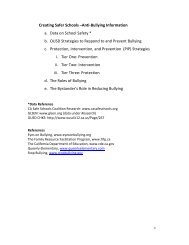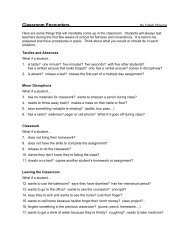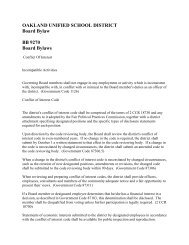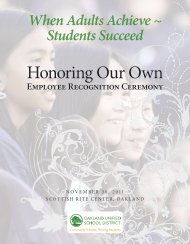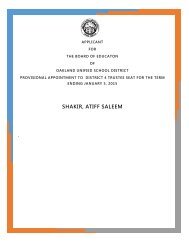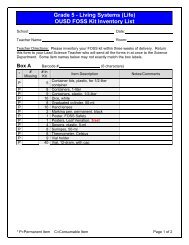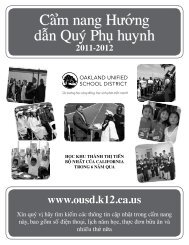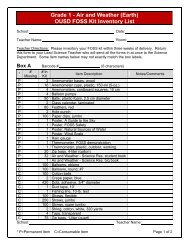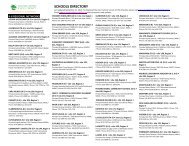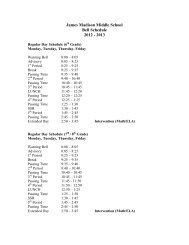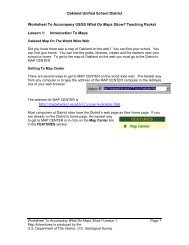Gang Prevention & - Oakland Unified School District
Gang Prevention & - Oakland Unified School District
Gang Prevention & - Oakland Unified School District
You also want an ePaper? Increase the reach of your titles
YUMPU automatically turns print PDFs into web optimized ePapers that Google loves.
<strong>Gang</strong> <strong>Prevention</strong> &Intervention HandbookAPPENDIXFunded by:Office of Juvenile Justice and Delinquency <strong>Prevention</strong>The City of <strong>Oakland</strong> ‐ Measure YCreated by:<strong>Oakland</strong> Interagency <strong>Gang</strong> <strong>Prevention</strong> CollaborativeOUSD – <strong>Gang</strong> <strong>Prevention</strong> & Intervention Handbook
C. <strong>Oakland</strong> <strong>Gang</strong>s by NeighborhoodThe following list provides some current <strong>Oakland</strong> gangs/sets organized by neighborhoods, oftenclaiming turf in specific geographic areas where they pursue illegal activities such as drug dealing.These turf designations may change over time and should be updated on a regular basis.West <strong>Oakland</strong> Turfs• Chestnut – 18 th St / 14 th St• Ghosttown – 29 th – 34 th St• Acorn Towers – 7 th & Market• Lower Bottoms – Campbell Village• Cypress Village – behind Cole <strong>School</strong>• Active Team – West <strong>Oakland</strong>• P-Team – Acorn, 8 th & AdelineNorth <strong>Oakland</strong>• North Side <strong>Oakland</strong> – North <strong>Oakland</strong>• Bushrod – near Mosswood Park• Norteno – Near <strong>Oakland</strong> Technical High <strong>School</strong>San Antonio / Fruitvale• Asian Crips - San Antonio Park area• Norteños – 2 nd Ave to High StreetCommon Norteño groups include:o East 7 tho Quince (15 th Ave)o 23 rd Ave.o UNTo Mitchell St.o 38th Locoso 36 tho 60’so TFC - “Too Fuckin’ Crazy”50’s (Avenues)• Sureños – 53 rd Ave to 58 th Ave (bordered by East 10 th to East 14 th / International Blvd)Common Sureno groups include:o South Side Locos (SSL) o East Side Locos (ESL – female gang)East <strong>Oakland</strong>• Black Team – Allendale area• Border Brothers – 70 th Ave – 105 th AveCommon Border Brothers groups include:o 81st Streeto 94th Streeto 96th Streeto Varrios Latino Brothers (VLB)o Don’t Fuck with Latinos (DFL)o On One BB’s – reference to being “on” drugsNo Particular Neighborhood/Turf• 211 MOB Squad named after Penal Code “211” for crimes such as robbery and muggings• 2FC (“Too F*ckin Crazy”)• Gas Team – West <strong>Oakland</strong> (and greater <strong>Oakland</strong>)• Baby Gas Team, Lady Gas Team & OG Gas Team• Dip SetOUSD – <strong>Gang</strong> <strong>Prevention</strong> & Intervention Handbook 3
Traditional <strong>Gang</strong>s: Norteño <strong>Gang</strong> SignsColor: Red Number: XIV (14)<strong>Gang</strong> members wear red accessories such as bandanas, rosaries,belts and backpacks. Rosaries and bandanas are often tucked awayduring school hours to avoid confiscation.Symbol: Bird<strong>Gang</strong> members identify with the number 14, as N isthe fourteenth letter in the alphabet. The tag on thebackpack reads OG (Original <strong>Gang</strong>ster) 14.Symbol: Nautical StarThe Bird is a recurring theme. Note the bird in the graffiti and onthe t-shirt logo paired with Norte 14. It is important to recognizethat the flag shown on the t-shirt is the symbol of the United FarmWorkers and does not by itself imply gang status.The Nautical Star is a play on the northern star. Thepicture on the right is a tag on a backpack.Sports Teams: Norteños wear apparel from a number of sports teams whose colors and logosare similar to the gangs.St. Louis Cardinals for thered bird.The Cincinnati Redsfor the color red.The NebraskaCornhuskers for thecolor red and “N”.A red <strong>Oakland</strong> A’s hatindicates activemembership.Additional ExamplesThe red backpack and nautical starindicate this youth is a member ofthe Norteños. The ”30” means theyouth lives in the 30’s—between30th and 39th Ave.This tag as found on a backpackis “LOC”, short for loco/crazy.The crossed out “S” is a sign ofdisrespect to the Surñeos.The above is an example of Norteño graffiti notethe red writing and nautical starts.OUSD – <strong>Gang</strong> <strong>Prevention</strong> & Intervention Handbook 5
Traditional <strong>Gang</strong>s: Sureño <strong>Gang</strong> SignsColor: Blue Number: 13<strong>Gang</strong> members wear blue accessories such as bandanas,rosaries, belts and backpacks. Rosaries and bandanas areoften tucked away during school hours to avoidconfiscation.<strong>Gang</strong> members identify with the number 13 as a sign ofrespect for the Mexican Mafia (M = 13 th letter of thealphabet). Note that the 13 is often paired with three dots.The tag on the left was confiscated from a studentnotebook. The graffiti on the right was from a school wall.Sports Teams: Sureños wear apparel from a number of sports teams whose colors and logosare similar to the gang’s.LA Dodgers for the color blue andsouthern California connection.Hand SignsSeattle Mariners for the color blue and“S”. The exploding star is seen as a signof disrespect towards Norteños.ShoesA blue <strong>Oakland</strong> A’s hat indicatesactive membership.Black Cortez Nikes are often worn by Sureños.GraffitiThe graffiti above is from a confiscated backpack. Thethree dots and blue lettering indicate Sureño. 58 th Ave is areference to the gang member’s neighborhood.This graffiti seen on a school bathroom door reads 187,X4, X3”. 187 is the penal code for murder, whichtranslates into “kill Norteño, signed Sureño”.OUSD – <strong>Gang</strong> <strong>Prevention</strong> & Intervention Handbook 6
Enterprise and Non‐Traditional <strong>Gang</strong>sUnlike the traditional Latino gangs, African American and Asian or Pacific Islander gangs and crewsare generally Enterprise or Non-traditional gangs. Both Enterprise and Non-traditional gangs areorganized around illegal activity. Enterprise gangs are focused on money-making activities, usuallydrugs and prostitution. While Non-traditional gangs may be involved in drugs and gangs, their focusis the violence and shock factor of crimes. As such Enterprise and Non-traditional gangs try to flybelow the radar and do not have a large visual display of signs, symbols or colors.There are, however, a few signs and symbols that might indicate membership in an Enterprise andNon-traditional gang or crew. See the pictures below for two examples.Non-Traditional or Enterprise <strong>Gang</strong>sAn A’s baseball cap of any color can represent activestatus in a gang. Some members will discreetly writeor embroider the name of their crew/turf on the cap.Some gang members will wear a t-shirt or hoodiewith the name of deceased gang or crew member torepresent their gang or crew and to intimidate rivals.It is more likely that staff may overhear student conversation about what neighborhood, block orturf they claim, but may not recognize graffiti or traditional gang signs. It is important to rememberthat there is no formula that tells someone a student is a gang member.The signs and symbols highlighted for Traditional, Enterprise and Non-traditional gangs are justexamples. Not all youth who have clothes and backpacks decorated with sport team logos, UnitedFarm Workers flags, birds, stars, specific number or colors are affiliated with a gang or crew. Manyof these items are common across youth culture in <strong>Oakland</strong> and are included in this Handbook asone of multiple indicators for gang involvement. It is especially important to note that youth oftenwear Rest In Peace t-shirts as a sign of respect and love for deceased friends and families.OUSD – <strong>Gang</strong> <strong>Prevention</strong> & Intervention Handbook 7
E. <strong>Oakland</strong> <strong>Unified</strong> <strong>School</strong> <strong>District</strong> Administrative Regulation—<strong>Gang</strong>sAR 5136: Students: <strong>Gang</strong>s (8/25/04)<strong>Prevention</strong> and Intervention MeasuresIn order to discourage the influence of gangs, school staff shall take the following measures:1. Any student displaying behavior, gestures, apparel or paraphernalia indicative of gangaffiliation shall be referred to the principal or designee.a. The student’s parent/guardian shall be contacted and may be asked to meet with schoolstaff.b. The student may be sent home to change clothes if necessary.(cf. 5132- Dress and Grooming)2. Staff members shall be provided with the names of known gang members.3. Students who seek help in rejecting gang associations may be referred to community-basedgang suppression and prevention organization.(cf. 1020- Youth Services)4. Any gang graffiti on school premises shall be removed, washed down or painted over assoon as discovered.a. Daily checks for graffiti shall be made throughout the campus.b. Graffiti shall be photographed before it is removed. These photographs shall be sharedwith local law enforcement authorities and used in future disciplinary or criminal actionagainst the offenders.(cf. 3515- Campus Security)(cf. 5131.5 – Vandalism, Theft and Graffiti)5. Classroom and after-school programs at each school shall be designed to enhance individualself esteem, provide positive reinforcement for acceptable behavior, and foster interest in avariety of constructive activities Some examples include:a. Explain the dangers of gang membershipb. Provide counseling for targeted at-risk studentsc. Include lessons or role-playing workshops in gang avoidance skills and nonviolentconflict resolution, including communication skills, anger management, ethnic/culturaltolerance, and mediation skills.d. Assign individual gang members to cooperative learning groups in which they may worktoward common goals with students who are not members of their gange. Provide school-to-career instruction(cf. 6030- Integrated Academic and Vocational Instruction)f. Provide positive interaction with local law enforcement staff(cf. 5137- Positive <strong>School</strong> Climate)6. <strong>Gang</strong> prevention lessons may be taught jointly by teachers and law enforcement staff.OUSD – <strong>Gang</strong> <strong>Prevention</strong> & Intervention Handbook 8
7. Staff shall actively promote membership in authorized student organizations which canprovide students companionship, safety, and a sense of purpose and belonging, including:a. Positive sports and cultural activities and affiliations with the local community(cf. 6145- Extracurricular and Co curricular Activities)(cf. 6145.2- Athletic Competition)b. Structured, goal-oriented community service projects(cf. 6142.4- Learning through Community Service)Community Outreach<strong>Gang</strong> prevention classes or counseling offered for parent/guardians should address the followingtopics:1. The dangers of gang membership2. Warning signs which may indicate that children are at risk of becoming involved with gangs3. The nature of local gang apparel and graffiti4. Effective parenting techniques5. Conflict resolution techniquesCommunity programs should address:1. The scope and nature of local gang problems2. Strategies by which each segment of the community may alleviate gang problems.F. <strong>Oakland</strong> <strong>Unified</strong> <strong>School</strong> <strong>District</strong> Board Policy—<strong>Gang</strong>sBP 5136: Students: <strong>Gang</strong>s (8/25/04)The Governing Board desires to keep district schools free from the threats or harmful influence ofany groups or gangs which exhibit drug use, violence or disruptive behavior. The Superintendent ordesignee shall take steps to deter gang intimidation of students and staff and confrontations betweenmembers of different gangs. He/she shall exchange information and establish mutually supportiveefforts with local law enforcement authorities.(cf. 3515.1- Crime Data Reporting)(cf. 5131.4- Campus Disturbances)(cf. 5131.7- Weapons and Dangerous Instruments)The Superintendent or designee shall provide in-service training which helps staff to identify gangsand gang symbols, recognize early manifestations or disruptive activities, and respond appropriatelyto gang behavior. Staff shall be informed about conflict management techniques and alerted tointervention measures and community resources.The Board realizes that students become involved in gangs for many reasons, such as peer pressure,the need for a sense of belonging, and lack of refusal skills. Age-appropriate gang violenceprevention education shall start with students in the early elementary grades, K-5.OUSD – <strong>Gang</strong> <strong>Prevention</strong> & Intervention Handbook 9
To further discourage the influence of gangs, the Superintendent or designee shall ensure thatschool rules of conduct and any school dress code prohibiting gang-related apparel are enforcedconsistently. If a student exhibits signs of gang affiliations, staff shall so inform the parent/guardian.(cf. 0450- Comprehensive Safely Plan)(cf. 5132- Dress and Grooming)(cf. 6164.2- Guidance/Counseling Services)G. <strong>Gang</strong> <strong>Prevention</strong> & Intervention Community ResourcesBelow is the <strong>Gang</strong> <strong>Prevention</strong> and Intervention section of the <strong>Oakland</strong> Community ResourcesDirectory. The full directory is available online at: www.ousd.k12.ca.us/communityresourcedirectory.Project New StartAlameda CountyService-Tattoo removal (ages 13-25)Alameda County Public Health Department, 1000 Broadway, 5th Floor, <strong>Oakland</strong>, CA 94607www.acphd.org/user/services/AtoZ_PrgDtls.asp?PrgId=53 ♦ 510-208-5926Mon-Fri 9am-5pm ♦ English and Spanish ♦ Bus:14Youth ALIVE! (Teens on Target and Caught in the Crossfire Programs)<strong>Oakland</strong>Service-Case management for Highland Hospital gun shot or physical assault victims and peerto-peerviolence prevention workshops to middle and high school students (ages 14-20)3300 Elm Street, <strong>Oakland</strong>, CA 94609youthalive.org/caught.html ♦ (510) 594-2588 ♦ Bus:1Crisis Response and Support Network<strong>Oakland</strong>Services- Support groups for people affected by homicide, critical family needs and emergencyhousing assistance, emancipated foster youth program, refugee services433 Jefferson Street, <strong>Oakland</strong>, CA 94607www.cceb.org ♦ (510)-768-3100LIBRE – Spanish Speaking Citizen’s FoundationFruitvale / East <strong>Oakland</strong>Services – L.I.B.R.E. Leading the Impendence of our Barrios for Raza Empowerment isfor youth who have demonstrated “at-risk” behaviors such as gang affiliation, truancy,suspension and/or expulsion for violence, or on probation. The program involves culturallyspecificand gender-specific cohorts of Latino young men and women.Office Address: 1470 Fruitvale Avenue, <strong>Oakland</strong>, CA 94601-2324www.sscf.org ♦ (510) 434-1808California Youth OutreachCentral & East <strong>Oakland</strong>Services- Street outreach in Central and East <strong>Oakland</strong> to reduce street violence. CYO alsoprovides school based services with a Youth Intervention Specialist providing case managementOffice Address: 4173 MacArthur Blvd #4, <strong>Oakland</strong>, CA 94619www.cyoutreach.org (510) 434-1949OUSD – <strong>Gang</strong> <strong>Prevention</strong> & Intervention Handbook 10
Healthy <strong>Oakland</strong>Services- Street outreach in West <strong>Oakland</strong> to reduce street violenceMailing Address: 2580 San Pablo Avenue, <strong>Oakland</strong>, CA 94612www.healthycommunities.us ♦ (510) 444-9655 ♦ (510) 653-1599Project ReConnect – Parenting Groups on <strong>Gang</strong> Awareness / <strong>Prevention</strong>Services- Parent workshops (targeting parents of youth ages 12-16 years old)6939 MacArthur Blvd, <strong>Oakland</strong>, CA 94605 ♦ projectreconnect@sbcglobal.nethttp://www.projectreconnect.net/ (510) 482-1738 ♦ (510) 482-1253 FaxWest <strong>Oakland</strong><strong>Oakland</strong>The Mentoring Center<strong>Oakland</strong>Services- Serves adjudicated and incarcerated youth - Young Men’s Groups, Young Women’sGroups, Mentoring, Parenting and Re-entry programs1221 Preservation Parkway, Suite 200, <strong>Oakland</strong>, CA 94612www.mentor.org ♦ (510) 891-0427 ♦ (510) 891-0492 FaxM, Th, F 9am-5pm and T, W 9am-7:30pm ♦ Bus:1M.I.S.S.S.E.Y., Inc:<strong>Oakland</strong>Services- Treatment and recovery for sexually exploited children (involved in “child or teenprostitution”)470 27 th street <strong>Oakland</strong> Ca 94612www.misssey.org ♦ On-Call Number: (510) 290.6450 ♦ Office 267-8840Case workers: M, F- 9am-6pm and M, W, F - 2pm-6pm ♦ Bus:51California Cities <strong>Gang</strong> <strong>Prevention</strong> NetworkCaliforniaServices- California Cities <strong>Gang</strong> <strong>Prevention</strong> Network led by the National Council on Crime andDelinquency (NCCD) and the National League of Cities. This network brings together leadersfrom <strong>Oakland</strong> (including the Mayor and law enforcement officials) with leaders from twelveother California Cities to share best practices related to gang violence.Page Tomblin: (510) 238-2350OUSD – <strong>Gang</strong> <strong>Prevention</strong> & Intervention Handbook 11
H. 2009 – 2010 Guest Speakers on <strong>Gang</strong> Awareness** <strong>Oakland</strong> gang awareness speakers. This is by no means an exhaustive list.California Youth Outreach<strong>Oakland</strong> based gang prevention and intervention agency providing both street outreach and schoolbased services.Henry Woods – (510) 434-1949 ♦ hwoods@cyoutreach.orgJermaine Ashley – Turf MinistriesMr. Ashley is currently starting up a non-profit called Turf Ministries.(510) 508-7935 ♦jermaineashley@gmail.comJuan Carlos Carmona – PRIDE / HTA ConsultingStatewide consultant and gang expert, Mr. Carmona provides technical assistance on gang issues.(510) 695-0509 ♦ mrcarmona@hotmail.comKarina Najera – LIBRE Program with Spanish Speaking Citizen’s FoundationRaised in <strong>Oakland</strong>, Ms. Najera runs LIBRE, a program serving youth who are gang-affiliated.(510) 261-7839 x 16 ♦ knajera@sscf.orgLt. Steven Fajardo - GREAT CurriculumLong term OUSD employee, Lt. Fajardo has worked with gangs in all facets including prevention,intervention and suppression.(510) 879-3670 ♦Steven.fajardo@ousd.k12.ca.usSystemic Solutions GroupProvides assessments, lectures and trainings on the subjects of education equity, povertyconsciousness and gang prevention.(415) 202-3069Victor Rios - Homeboy Goes to Harvardwww.homeboygoestoharvard.comOUSD – <strong>Gang</strong> <strong>Prevention</strong> & Intervention Handbook 12
I. Parent Guide<strong>School</strong>s occasionally have incidents that involve youth, either specific students, groups of studentsor youth from the community and want to provide parents with information, either school-wide oron an individual basis. Please adapt this section as necessary for your school.The <strong>Oakland</strong> <strong>Unified</strong> <strong>School</strong> <strong>District</strong> is committed to keeping all of our students safe at school and,as much as possible, to and from school. As a parent, we are sure you share our commitment tosafety for your son(s) or daughter(s).As you probably know, we have a serious gang problem in <strong>Oakland</strong>. It affects us all by making ourstreets into rival gang turf. If we are not careful, these problems will enter our schools and makethem unsafe for students. We are doing our best to eliminate gangs from our schools, and we hopeyou will join us in keeping your children safe from the influence of gangs.You might ask, “What can I do to help?” Our hope is that we can communicate with you and giveyou support and that you can help us as well. One important way you can help is to be very aware ofthe “signs” of potential gang involvement among your children and their friends.SignsThe presence of any one of the following “signs” by itself does not necessarily mean that your childor their friends are involved in a gang. But some warning signs are a cause for more concern - suchas practicing gang hand signs and graffiti. Warning signs should be considered together.How your child is dressing. Many gangs use colored clothing, sports team logos on clothing, acertain style of clothing, or clothing accessories (hair ties, shoe laces, belts, etc.) to denote gangmembership (i.e. a hat of a particular sports team). You should keep an eye out for groups of youthwho are wearing the same hairstyle, nail polish, shoes/laces, belt and rosaries in the same color.These may signal membership in a particular gang. But parents should also be aware that typicalstudent dress may include sports team jackets, white tee shirts, jeans and a hoodie, and this is notgang attire. If your son or daughter likes a certain sports team and dresses with that team’s logo, itcould be normal behavior.Tattoos. <strong>Gang</strong> members use tattoos to say which gang they claim. Elementary or middle schoolkids may use a pen or magic marker to draw the gang’s name or initials on their body. They may alsodraw their gang nickname and use other gang slogans for their tattoos. Older children/youth maycarve gang-related symbols or words into their skin. Eventually this can lead to getting a permanenttattoo. A teen who proudly displays a fake or real gang tattoo is demonstrating that she or he wantsto join a gang. Girls sometimes tattoo the letter abbreviation for a gang on their neck. 1Defiant Behavior and Tough Image. Most teens are defiant sometimes. If they are involved in agang they might be very defiant toward you as a parent and even threaten you. If your child isinvolved with a gang they may believe that a very tough image is important. He or she may begin toact very tough, cursing and being defiant whenever they are confronted.1In between these letters, put numbers/dots/ roman numerals associated with the gang.OUSD – <strong>Gang</strong> <strong>Prevention</strong> & Intervention Handbook 13
New friends. Your teen may begin to associate with a new group of friends and no longer associatewith long-time friends. If these new friends all dress in similar styles or colors, parents shoulddiscuss why he/she is associating with this new group of friends.Starts using nickname. In the world of gangs you are nobody until you have earned a nickname.<strong>Gang</strong> members refer to each other by nickname. You should be aware if your teen is referred to by anew nickname that may be associated with gangs or violence, such as “Sniper, L’il Killa, C-Dawg,Flaco”, and so on.Secrecy. <strong>Gang</strong>-involved teens often have gang-related paraphernalia, pictures, samples of graffiti,etc. They may hide gang paraphernalia, drugs or weapons in the house. They may not want you tosee graffiti written on clothing, backpacks, furniture or the walls of their bedrooms. They may try toinstall a lock on the bedroom door or threaten you if you try to get into their bedroom. MySpaceand Facebook and Twitter accounts may also be used for gang communications.Money. Some teens get involved in gangs to make money illegally. Crimes may include armedrobbery, selling drugs, being a lookout for drug dealers, auto theft/burglary, and so forth. Youshould be concerned if your teen has unexplained money or expensive items like new clothes, cellphones, video game players, computer games or jewelry that begin to appear without a reasonableexplanation.Unusual sleeping patterns. Teenagers naturally need more sleep than adults, but gang memberslike to hang out late at night when they conduct their illegal activities. If your teens are sleeping verylate, missing school, and appear to have been under the influence of drugs or alcohol, you should beconcerned – whether this is as a result of gang activity or other issues.Cuts and bruises. <strong>Gang</strong> members tend to get into more fights than other teens. Be aware ofunexplained cuts and bruises, especially on the knuckles and hands, and secrecy as to how theyoccurred.Graffiti and Tagging. Graffiti can be the name of a gang, initials, numbers or symbols that areassociated with the gang. Graffiti is not just written on the walls of buildings but can be found onbooks, notebooks, backpacks, clothing and furniture. Graffiti is used to mark gang territory ordemonstrate involvement in a gang. If your teen is involved with a gang, he/she will generally havegraffiti written on personal possessions. This may also include drawings and doodling of gangrelated themes of violence, guns, or symbols.Practicing behaviors. Teens who are interested in a gang will practice gang-related behaviors. Theywill usually practice graffiti writing on paper or notebooks. You may observe your son or daughterstaring into a mirror, practicing a tough and menacing stare, often referred to as “mad-dogging”.Teens just beginning gang involvement will spend hours practicing the hand signs of the gang.Alcohol/drug abuse. <strong>Gang</strong> members often have easy access to alcohol and other drugs. Someyouth get involved with gangs just to “party”. Alcohol/drug abuse can include common householdOUSD – <strong>Gang</strong> <strong>Prevention</strong> & Intervention Handbook 14
medicines like Robutussin (also known as “bo” when mixed with Sprite) or sniffing glue. Studentsmay conceal alcohol drinks in soda containers.What Can I Do?Try to talk calmly with your child no matter how upset the possibility of gang membership makesyou. Ask your child if they are in a gang, and why. Avoid being quick to judge. Recognize that gangmembership is not just the child's problem, it's the family's problem as well.• Talk to your children about gangs and ways to avoid them.• Let them know that you disapprove of gangs and do not want to see them hurt orarrested.• Redefine the rules your child must follow and enforce them.• Seek outside help if your child won't talk, is difficult to communicate with, or if yoususpect your child is lying.• Supervise your child's activities, know their friends and their friend's parents. Makesure you know how your child is spending their free time.• Get your child involved in supervised, positive group activities that interest them andhelp them develop a sense of belonging.• Develop open and frequent communication with your child so that they will come toyou if they have a problem. Make no topic off limits.• Spend positive time with your child. Plan activities the whole family can enjoy, butalso spend time alone with your child.• Get involved in your child's education. Put a high value on education and help themto do their best in school. Keep close contact with your child's teachers before anyproblems develop.• Do not allow your child to dress in gang-style clothing, use gang gestures or writegang names, symbols or graffiti on books, clothes, public property or on themselves.• Establish a clear family position on drugs. Kids who know their parents disapproveof drug use are less likely to use them.• Build your child's self-esteem. Focus on your child's good points and praise positivebehavior. Help your child feel good about themselves. 2The advice above presumes that you still maintain some control over your child. If you feel,however, that you have lost any ability to control his/her behavior, it is time to look for help fromone of the agencies that specializes in gang prevention and intervention. (See <strong>Gang</strong> <strong>Prevention</strong> andIntervention Resources on page 10.) Sometimes a “peer” case manager or mentor can make aneffective intervention with your son/daughter because they have had personal history with ganginvolvement and have managed to get out of the gang lifestyle. It is very important that the casemanager knows that you, as the parent(s), are backing them up at home and that you communicatewith each other while still respecting the confidentiality of the relationship between the case managerand your child.2 http://www.claytonpolice.org/nc/GETINFORMED/<strong>Gang</strong>s/parentsguide/tabid /143/Default.aspxOUSD – <strong>Gang</strong> <strong>Prevention</strong> & Intervention Handbook 15



